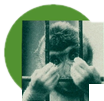News archive
Impressions from the Conference and Workshop Biological Barriers
Wednesday, 14 March 2012 09:54The workshop and congress Biological Barriers on 29th February to 9th March 2012 at Saarland University was held under the titel „Biological Barriers – in vitro and in silico Tools for Drug Delivery and Nanosafety Research“ for the ninth time.
Project Start: 3R-alternative methods to improve legally required animal testing
Tuesday, 28 February 2012 09:59Today test methods for immunological medicinal products are based on animal experiments. With the help of the 3R concept (replacement, reduction and refinement) application and suffering of animals in experiments required by law can be reduced or avoided completely.
Allergan: Cell-based in vitro-assay for Botox products in Germany and Europe
Friday, 24 February 2012 10:00The German Federal Institute of Drugs and Medical Devices (BfArM) has approved an animal-free procedure for testing of Allergan´s botulinum products.
Mathematicians Clarify Molecular Details of Dynamin Molecule
Wednesday, 22 February 2012 10:02A Berlin researcher cooperative succeeded in clarifying functional details of the dynamin molecule.
Parkinson´s Disease: New Insights from Cell Cultures
Wednesday, 15 February 2012 10:04American scientists led by Jian Feng from the State University of New York at Buffalo have transformed skin cells of patients who are suffering from Parkinson´s into induced pluripotent stem cells (iPS) an than into nerve cells.
Call for submission: EPAA SCIENCE AWARD 2012
Wednesday, 01 February 2012 10:06The European Partnership for Alternative Approaches to Animal Testing (EPAA), a cooperation between the European Commission and industry from various sectors, is organising for the second time its Science Award, worth up to 100 000 €.
University of Applied Sciences Jena: Successful Degree with microfluidic Cell Cultivation
Friday, 27 January 2012 10:29As a first graduate of the MSc course "miniaturized biotechnology", offered by the Department of Mediocal Technology and Biotechnology of the University of Applied Sciences Jena, in her final studies a student developed a new method for microfluidic cultivation of cells.
Mechanical compression enhances migration of cancer
Saturday, 07 January 2012 10:42American scientists headed by Janet Tse at the Massachusetts Institute of Technology (MIT) in Cambridge exposed different breast cancer cell lines to different pressures. They found out that these breast cancer cells penetrate into surrounding healthy tissue and can therefore promote the spread of cancer.
Stem cells detected in the retina
Friday, 06 January 2012 10:48American scientists have detected a previously unknown type of stem cells in the retina of the human eye.
Applications for the German Thesis Award 2012 now possible
Thursday, 05 January 2012 10:46Each year the Körber Foundation presents the German Thesis Award for the year’s most important dissertations. Applications can be submitted until 1 March 2012.



 Dr. rer. nat.
Dr. rer. nat. Menschen für Tierrechte - Tierversuchsgegner Rheinland-Pfalz e.V.
Menschen für Tierrechte - Tierversuchsgegner Rheinland-Pfalz e.V.